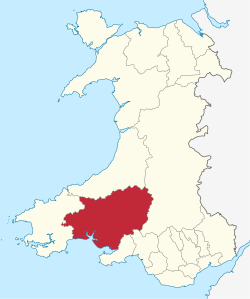
Carmarthenshire is a large rural county in West Wales. It includes a mix of upland and mountainous terrain and fertile farmland. The western end of the Brecon Beacons National Park lies within the county. Across Carmarthenshire there are a total of 370 scheduled monuments. That is too many to have on a single list page, so for convenience, the list is divided into the 227 prehistoric sites and the 143 Roman, Medieval and Post Medieval sites.
Contents
Carmarthenshire is both a unitary authority and a historic county. Between 1974 and 1996 it was merged with Cardiganshire (now Ceredigion) and Pembrokeshire to form Dyfed.
